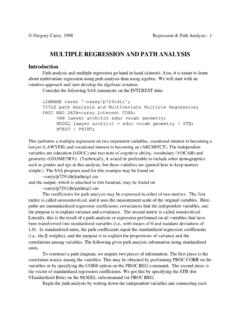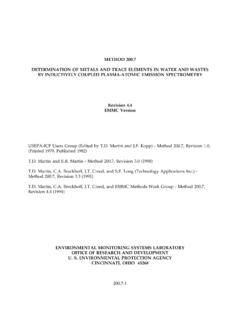Transcription of Introduction to Matrix Algebra
1 Psychology 7291: Multivariate Statistics (Carey) 8/27/98 Matrix Algebra - 1 Introduction to Matrix AlgebraDefinitions:A Matrix is a collection of numbers ordered by rows and columns. It is customaryto enclose the elements of a Matrix in parentheses, brackets, or braces. For example, thefollowing is a Matrix :X = 582 107 .This Matrix has two rows and three columns, so it is referred to as a 2 by 3 Matrix . Theelements of a Matrix are numbered in the following way:X = x11x12x13x21x22x23 That is, the first subscript in a Matrix refers to the row and the second subscript refers tothe column. It is important to remember this convention when Matrix Algebra vector is a special type of Matrix that has only one row (called a row vector) orone column (called a column vector).
2 Below, a is a column vector while b is a rowvector. a=723 ,b= 274()A scalar is a Matrix with only one row and one column. It is customary to denotescalars by italicized, lower case letters ( , x), to denote vectors by bold, lower case letters( , x), and to denote matrices with more than one row and one column by bold, uppercase letters ( , X).A square Matrix has as many rows as it has columns. Matrix A is square butmatrix B is not square: A=1632 ,B=19037 2 A symmetric Matrix is a square Matrix in which xij = xji for all i and j. Matrix A issymmetric; Matrix B is not ,B=915262517 A diagonal Matrix is a symmetric Matrix where all the off diagonal elements are0.
3 Matrix A is 7291: Multivariate Statistics (Carey) 8/27/98 Matrix Algebra - 2 A=900060007 An identity Matrix is a diagonal Matrix with 1s and only 1s on the diagonal. Theidentity Matrix is almost always denoted as I. I=100010001 Matrix Addition and Subtraction:To add two matrices, they both must have the same number of rows and they bothmust have the same number of columns. The elements of the two matrices are simplyadded together, element by element, to produce the results. That is, for R = A+ B, then rij=aij+bijfor all i and j. Thus, 951 476 =19 2360 +8 43 716 Matrix subtraction works in the same way, except that elements are subtracted instead Multiplication:There are several rules for Matrix multiplication.
4 The first concerns themultiplication between a Matrix and a scalar. Here, each element in the product Matrix issimply the scalar multiplied by the element in the Matrix . That is, for R = aB, then rij=abijfor all i and j. Thus, 82637 =16482456 Matrix multiplication involving a scalar is commutative. That is, aB = next rule involves the multiplication of a row vector by a column vector. Toperform this, the row vector must have as many columns as the column vector has rows. For example, 175()241 is legal. HoweverPsychology 7291: Multivariate Statistics (Carey) 8/27/98 Matrix Algebra - 3 175()2416 is not legal because the row vector has three columns while the column vector has fourrows.
5 The product of a row vector multiplied by a column vector will be a scalar. Thisscalar is simply the sum of the first row vector element multiplied by the first columnvector element plus the second row vector element multiplied by the second columnvector element plus the product of the third elements , etc. In Algebra , if r = ab, then r=aii=1n biThus, 263()814 =2 8+6 1+3 4=34 All other types of Matrix multiplication involve the multiplication of a row vectorand a column vector. Specifically, in the expression R = AB, rij=ai b jwhere ai is the ith row vector in Matrix A and b j is the jth column vector in Matrix B.
6 Thus, if A=28 1364 ,andB=179 263 then r11=a1 b 1=281()196 =2 1+8 9+1 6=80and r12=a1 b 2=281()7 23 =2 7+8 ( 2)+1 3=1and r21=a2 b 1=364()196 =3 1+6 9+4 6=81andPsychology 7291: Multivariate Statistics (Carey) 8/27/98 Matrix Algebra - 4 r22=a2 b 2=364()7 23 =3 7+6 ( 2)+4 3=21 Hence, 28 1364 179 263 =8018121 For Matrix multiplication to be legal, the first Matrix must have as many columns as thesecond Matrix has rows. This, of course, is the requirement for multiplying a row vectorby a column vector. The resulting Matrix will have as many rows as the first Matrix andas many columns as the second Matrix .
7 Because A has 2 rows and 3 columns while B has3 rows and 2 columns, the Matrix multiplication may legally proceed and the resultingmatrix will have 2 rows and 2 of these requirements, Matrix multiplication is usually not commutative. That is, usually AB BA. And even if AB is a legal operation, there is no guarantee thatBA will also be legal. For these reasons, the terms premultiply and postmultiply are oftenencountered in Matrix Algebra while they are seldom encountered in scalar special case to be aware of is when a column vector is postmultiplied by a rowvector. That is, what is 347 82()?In this case, one simply follows the rules given above for the multiplication of twomatrices.
8 Note that the first Matrix has one column and the second Matrix has one row,so the Matrix multiplication is legal. The resulting Matrix will have as many rows as thefirst Matrix (3) and as many columns as the second Matrix (2). Hence, the result is 347 82()= 24 63285614 Similarly, multiplication of a Matrix times a vector (or a vector times a Matrix ) will alsoconform to the multiplication of two matrices. For example, 856194 285 is an illegal operation because the number of columns in the first Matrix (2) does notmatch the number of rows in the second Matrix (3). However,Psychology 7291: Multivariate Statistics (Carey) 8/27/98 Matrix Algebra - 5 856194 37 =8 3+5 76 3+1 79 3+4 7 =592555 and 273()856194 =2 8+7 6+3 92 5+7 1+3 4()=8529()The last special case of Matrix multiplication involves the identity Matrix , I.
9 Theidentity Matrix operates as the number 1 does in scalar Algebra . That is, any vector ormatrix multiplied by an identity Matrix is simply the original vector or Matrix . Hence, aI =a, IX = X, etc. Note, however, that a scalar multiplied by an identify Matrix becomes adiagonal Matrix with the scalars on the diagonal. That is, 41001 =4004 not 4. This should be verified by reviewing the rules for multiplying a scalar and a matrixgiven Transpose:The transpose of a Matrix is denoted by a prime ( A ) or a superscript t or T ( At or AT). The first row of a Matrix becomes the first column of the transpose Matrix , thesecond row of the Matrix becomes the second column of the transpose, etc.
10 Thus, A=271864 ,andAt=287614 The transpose of a row vector will be a column vector, and the transpose of a columnvector will be a row vector. The transpose of a symmetric Matrix is simply the Inverse:In scalar Algebra , the inverse of a number is that number which, when multipliedby the original number, gives a product of 1. Hence, the inverse of x is simple 1/x. or, inslightly different notation, x 1. In Matrix Algebra , the inverse of a Matrix is that matrixwhich, when multiplied by the original Matrix , gives an identity Matrix . The inverse of amatrix is denoted by the superscript -1 . Hence, AA 1=A 1A=IA Matrix must be square to have an inverse, but not all square matrices have aninverse.




